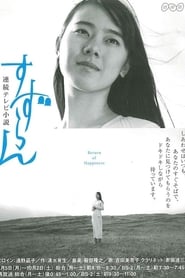Nhk TV Series
-
Oshin
1983
star 6.7Oshin is a Japanese serialized morning television drama, which aired on broadcaster NHK from April 4, 1983 to March 31, 1984. The series follows the life of Shin Tanokura during the Meiji period up to the early 1980s. Shin was called "Oshin", which is an archaic Japanese cognomen. -
Toto Nee-chan
2016
star 8.5In 1930 and as a young child, Tsuneko Kohashi lives at Enshu in Shizuoka Prefecture. She has a happy life with her parents and two younger sisters. Things change after her father dies from tuberculosis. Her father asked Tsuneko Kohashi to take care of the family in his place. Due to financial difficulties, her mother Kimiko decides to move the family to Tokyo where Tsuneko's grandmother lives. -
Tenka
2004
Tenka
2004
-
Scarlet
2019
star 7.5Born in 1937 in Osaka as the eldest daughter, Kawahara Kimiko moves to Shigaraki with her family at the age of 9. She works to support her family from a young age. Eventually, she jumps into the male world of pottery and becomes a pioneer of female ceramic arts. After marrying her husband who is also involved in ceramics and owning her own kiln, she raises her two children while struggling to create unique ware. -
Massan
2014
star 8Massan is based on the lives of Masataka Taketsuru and his wife Jessie Roberta "Rita" Cowan, a Scotswoman Taketsuru met while studying abroad. -
Futarikko
1996
star 7.3Born over a tofu shop in Osaka, twin sisters Reiko and Kyoko have very different characters. Reiko is diligent, and longs for a secure, middle class lifestyle. Kyoko is a free spirit, who seeks thrills and adventure. -
Natsuzora
2019
star 7Okuhara Natsu was born in Tokyo in 1937. In 1945, she loses both parents to war and becomes an orphan, but her father’s comrade, Shibata Takeo, takes her in and moves to Tokachi in Hokkaido. In an unfamiliar land surrounded by unfamiliar people, Natsu feels lost at first, but surrounded by Tokachi’s vast nature and its strong, yet compassionate people, she grows up to be a strong girl. When Natsu enters elementary school, she meets Yamada Tenyo who draws lovely pictures of horses. Tenyo tells her that in America, animation in which pictures move is becoming popular, Natsu’s curiosity is piqued. Upon graduating high school, Natsu goes to Tokyo to look up her brother, and takes a jump into the world of animation. -
Kokoro
2003
Kokoro
2003
Suenaga Kokoro, an international flight attendant, lives with her mother and grandmother who operate a traditional restaurant in a lively downtown district of Tokyo where customs and traditions run deep and neighbors know each other like a big family. -
Teppan
2010
star 8Teppan is a Japanese television drama that aired on NHK in 2010–2011. It was the 83rd Asadora. It starred a new actress, Miori Takimoto, in the role of a young woman raised by an adopted family in Onomichi who learns of her real grandmother and decides to move to Osaka to start an okonomiyaki restaurant. The title word "teppan" refers to the metal surface on which okonomiyaki are cooked. The series, while interrupted by the Tohoku Earthquake, averaged a 17.2% rating, making it the fourth most popular of the Asadora dramas in the previous five years. -
Jun to Ai
2012
Jun to Ai
2012
Jun to Ai is a Japanese television drama series. It debuted on October 1, 2012 and was broadcast until March 30, 2013. It is about a girl named Jun Kanō, raised in Miyakojima, Okinawa, who moves to Osaka to work in a hotel. There she meets a man named Itoshi Machida, with whom she falls in love. It is the 87th NHK Asadora. -
Hiyokko
2017
star 8.2The 17-year-old Yatabe Mineko grew up in a family of seven in a mountain village in northeastern Ibaraki Prefecture. Her father Minoru has gone to Tokyo to work in order to earn extra money. However, her life completely changes when her father does not come back for the New Year. Mineko asks her family to let her go to Tokyo to find him and promises to send money home. In the autumn of 1964, she and two childhood friends Tokiko and Mitsuo are hired to start working at a small factory in Tokyo’s working class neighborhood. After work each day, Mineko searches for her father and gets disheartened at times. Mineko overcomes challenges and starts to lay down roots in Tokyo as she experiences many meetings and farewells amid the laughter and tears with regulars, people of the shopping street, friends, and colleagues. But will she be able to find her father? -
Suzuran
1999
star 8.5In 1924, a time when both steam engine trains and early Showa Era's first train stations are just beginning. In the waiting room of Asumoe Station, a small country station, a passenger finds an abandoned baby and rushes to tell the station master, Tokiwa Jiro. The news quickly spreads and soon friends of Tokiwa's along with other townsfolk are saying that this baby must be a gift, it is Tokiwa's recently departed beloved wife reborn as a baby. -
チロリン村物语
1992
チロリン村物语
1992
-
Chimudondon
2022
star 8Higa Nobuko was born and raised with her four siblings in a farmhouse in the "Yanbaru region" in the northern part of the main island of Okinawa. She aims to become a chef drawing inspiration from Okinawan cuisine. The four siblings follow very different paths, but the memories of their hometown connect their hearts and they're able to overcome their hardships as a family. -
Hitomi
2008
Hitomi
2008
The 78th NHK Asadora is Hitomi. The series takes place in the old shitamachi area of Tokyo, and in these most recent episodes, 20-year old heroine Hitomi becomes the force around which her divorced mother, long estranged from her own father, is forced to reconcile and renew a sense of family camaraderie. This is not particularly easy, given the trifling issues and problems of modern day life that beset each of the characters, and the drama unfolds with a light comedic touch. Hitomi's upbringing is the issue that is constantly brought into focus. The family reconciliation is made possible, ironically through the death of Hitomi's grandmother. Hitomi seizes the opportunity to travel to her funeral from Sapporo. Once there, she sets out to realize her dream of becoming a dancer, all the while interfering with and disrupting her grandfather's life. -
Major
2004
star 8.5Honda Goro the son of a famous baseball player loves nothing more than baseball itself. His biggest dream is to show his father that he can become the best pitcher in the world despite all the hardships he had to endure he keeps on running towards his goal at full speed. -
Jun-chan's Cheering Song
1988
The year is 1947, August. Ono Junko's family is being evacuated to Wakayama and the father is going to war. A few years later, the father has returned from Manchuria but he also brought a boy that had been abandoned by his mother. The boy is Yuta and the family will adopt him. -
Mare
2015
star 7.7Mare is an elementary school student. She lives with her family in the city, but, right before her father goes bankrupt, they run away and settle down at a fishing village in Noto. The family rents a couple's home who run a salt pond. Mare's father starts a new business, but it also fails. Her mother supports the family by working at the salt pond. 8 years later, Mare, about to graduate from high school, decides to work for the Wajima local government. She wants to have a steady job, unlike her father. Her job is to support people who move to Noto. -
Tsubasa
2009
Tsubasa
2009
The story follows the 20-year-old Tsubasa who dedicates her life to her family and their shop. Her life is turned upside down when her mother who was missing came back home. To pay of her mother's debt she starts to work at a small radio station as a DJ.



















